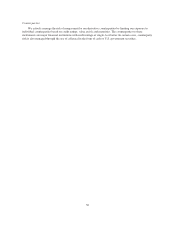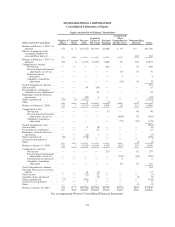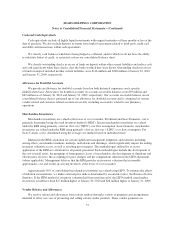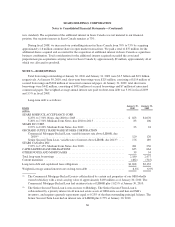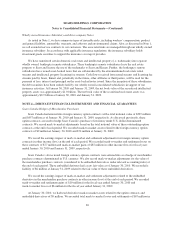Sears 2009 Annual Report Download - page 60
Download and view the complete annual report
Please find page 60 of the 2009 Sears annual report below. You can navigate through the pages in the report by either clicking on the pages listed below, or by using the keyword search tool below to find specific information within the annual report.SEARS HOLDINGS CORPORATION
Notes to Consolidated Financial Statements—(Continued)
appropriate for analyzing our indefinite-lived assets. This method is based on the assumption that, in lieu of
ownership, a firm would be willing to pay a royalty in order to exploit the related benefits of this asset class. The
Relief from Royalty Method involves two steps: (i) estimation of reasonable royalty rates for the assets and
(ii) the application these royalty rates to a net sales stream and discounting the resulting cash flows to determine
a value. We multiplied the selected royalty rate by the forecasted net sales stream to calculate the cost savings
(relief from royalty payment) associated with the assets. The cash flows are then discounted to present value by
the selected discount rate and compared to the carrying value of the assets.
Financial Instruments and Hedging Activities
We are exposed to fluctuations in foreign currency exchange rates as a result of our net investment in Sears
Canada. Further, Sears Canada is exposed to fluctuations in foreign currency exchange rates due to inventory
purchase contracts denominated in U.S. dollars. As a result, we primarily use derivatives as a risk management
tool to decrease our exposure to fluctuations in the foreign currency market. We primarily use foreign currency
forward contracts to hedge the foreign currency exposure of our net investment in Sears Canada against adverse
changes in exchange rates and foreign currency option contracts to hedge against foreign currency exposure
arising from Sears Canada’s inventory purchase contracts denominated in U.S. dollars.
We use derivative financial instruments, including interest rate swaps and caps, to manage our exposure to
movements in interest rates. In addition, we from time to time have entered into total return swaps as a means for
investing a portion of our surplus cash, although we did not do so in fiscal 2009 or 2008.
Hedges of Net Investment in Sears Canada
When applying hedge accounting treatment to our derivative transactions, we formally document our hedge
relationships, including identification of the hedging instruments and the hedged items, as well as our risk
management objectives and strategies for undertaking the hedge transaction. We also formally assess, both at
inception and at least quarterly thereafter, whether the derivatives that are used in hedging transactions are highly
effective in offsetting changes in either the fair value or cash flows of the hedged item. If it is determined that a
derivative ceases to be a highly effective hedge, we discontinue hedge accounting.
For derivatives that are designated as hedges of our net investment in Sears Canada, we assess effectiveness
based on changes in spot currency exchange rates. Changes in spot rates on the derivatives are recorded in the
currency translation adjustments line in Accumulated Other Comprehensive Income and remain there until such
time that we substantially liquidate or sell our holdings in Sears Canada.
Sears Canada Hedges of Merchandise Purchases
Sears Canada mitigates the risk of currency fluctuations on offshore merchandise purchases denominated in
U.S. currency by purchasing U.S. dollar denominated option contracts for a portion of its expected requirements.
Since Holdings’ functional currency is the U.S. dollar, we are not directly exposed to the risk of exchange rate
changes due to Sears Canada’s merchandise purchases, and therefore we do not account for these instruments as
a hedge of our foreign currency exposure risk. Changes in the fair value of these contracts are recorded in the
consolidated statement of income as a component of other income each period.
Hedges of Interest Rates
For interest rate swaps and caps that have been designated and qualify as hedges, both the effective and
ineffective portions of the changes in the fair value of the derivative, along with the offsetting gain or loss on the
60


